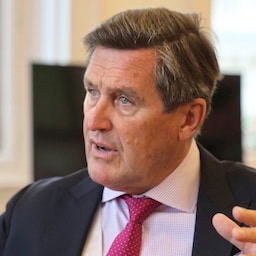Investment worth millions
District cooling to make Vienna the coolest city
A year earlier than planned, the district cooling ring around the city center has now been closed. Environment and economy benefit.
Many ministries, hotels, cultural institutions and company complexes are located around the magnificent Ringstrasse. Until now, they could only be cooled using energy-guzzling and CO2-intensive air conditioning systems. They also produced a lot of hot air. Which has also driven up the temperature of the city. The result: "The number of tropical nights has increased significantly in recent years," says Wien Energie boss Michael Strebl. Cooling has become increasingly complex and energy-intensive. This will change.
Work completed ahead of schedule
The district cooling ring around the city center went into operation a year earlier than planned. The joint project between Wiener Stadtwerke, Wien Energie and Wiener Netze cools the connected buildings with 100 percent renewable energy. The connection of the district cooling plants on Schottenring and Stubenring via a 4.7-kilometre-long network of pipes has the advantage that, in addition to supply security, cooling can be very efficient, i.e. energy-saving. This protects the environment.
The hot summers of recent years underline the growing importance of sustainable cooling systems such as district cooling in a large city. As temperatures rise, so does the need for efficient and environmentally friendly cooling systems to ensure the quality of life of the Viennese.

Wirtschaftsstadtrat Peter Hanke
Bild: Zwefo
Boost for the economy
But the economy also benefits. Stadtwerke CEO Peter Weinelt: "One euro invested by us here triggers follow-up investments amounting to four euros. The importance of district cooling in economic terms will continue to grow." The city will invest a further 90 million euros in environmentally friendly cooling technology by 2027. Vienna's City Councillor for Economic Affairs Peter Hanke is also happy: "As temperatures rise, the need for efficient and environmentally friendly cooling systems is growing. This is also in demand from the economy. With these investments, we really are the district cooling capital of Europe."
How district cooling works
District cooling is generated in our own centers with highly efficient chillers in the form of cold water. In addition to electricity, surplus heat from waste incineration is also used as drive energy in summer. The water, which is cooled to around 5-6 degrees Celsius, is transported directly to the customers via the company's own district cooling network and distributed in the buildings via the in-house cooling systems. The water absorbs the heat from the building and transports it away. Re-cooling is also carried out centrally, for example using water from the Vienna Canal. This is also good for the environment: compared to conventional air conditioning units, district cooling saves around 50 percent CO2. District cooling is powered by 100 percent renewable electricity.
This article has been automatically translated,
read the original article here.












Da dieser Artikel älter als 18 Monate ist, ist zum jetzigen Zeitpunkt kein Kommentieren mehr möglich.
Wir laden Sie ein, bei einer aktuelleren themenrelevanten Story mitzudiskutieren: Themenübersicht.
Bei Fragen können Sie sich gern an das Community-Team per Mail an forum@krone.at wenden.